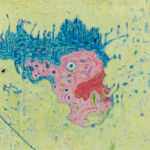Ross Taylor
70 7/8 x 47 1/4 in.
Further images
The title of the piss yellow canvas refers to use of urine to change the colour and make up of a material, and how this base bodily by-product can represent something collected and treasured in past times as precious. Distorted faces and liberated body parts appear as characters that simmer and loom in this potent mix.
Taylor’s work demands physical perambulation from the viewer - a stepping in and out of his world to appreciate emergent floating forms and how the “the most badly treated and dismissed bit of linen … always make the juiciest surface”. He sees painting as a state or atmosphere, something real and unreal, figurative and abstract all at the same time, that generates a moving place wherein to find meaning.
The painting is oil on linen and a closer inspection reveals the archaeology of this canvas over the artist’s revisitings of many years, which has been scored, scraped to the weave as texture or fallen in places into holes as dark voids.
Taylor sometimes describes his studio as a stomach: a swilling and churning dual sphere of production and consumption, where all that enters is incessantly gnawed, singed and regurgitated, and where his inner world of personal stories and fictional characters, develops. His paintings emerge over several years through a process of painting and re-working until the final iteration rises to the surface. Sometimes abstract, sometimes bearing reference to figures or forms, internalised fictions rise and external influence seeps in.
“I like to think about paintings coming from this dark space, set amongst the hypnagogic dark and dank terrior that represents the ambiguity of the creative process. A place, fizzy with habits and indecision, where practice and method become redundant, and in their place the monstrous and all that is unidentifiable seep. Bad habits, good habits, objects made from boredom, from damage and internal mutterings. The kinds of actions and behaviours that belong to the margins of your day, where you pick and scratch, wait and stare, allowing your attention to be removed from the matter at hand. A place in which in-built fictions can intermingle, morph, and collide, and maintain the hallucinations, patterns and images that unlock the biological happenings and evolutionary knowledge that the artistic journey encapsulates - where a work might ‘happen’”.
Exhibitions
By the Skin of Our Teeth (2022), Brooke Benington, LondonLiterature
The Wick, Spotlight Interview with Ross Taylor (online)









